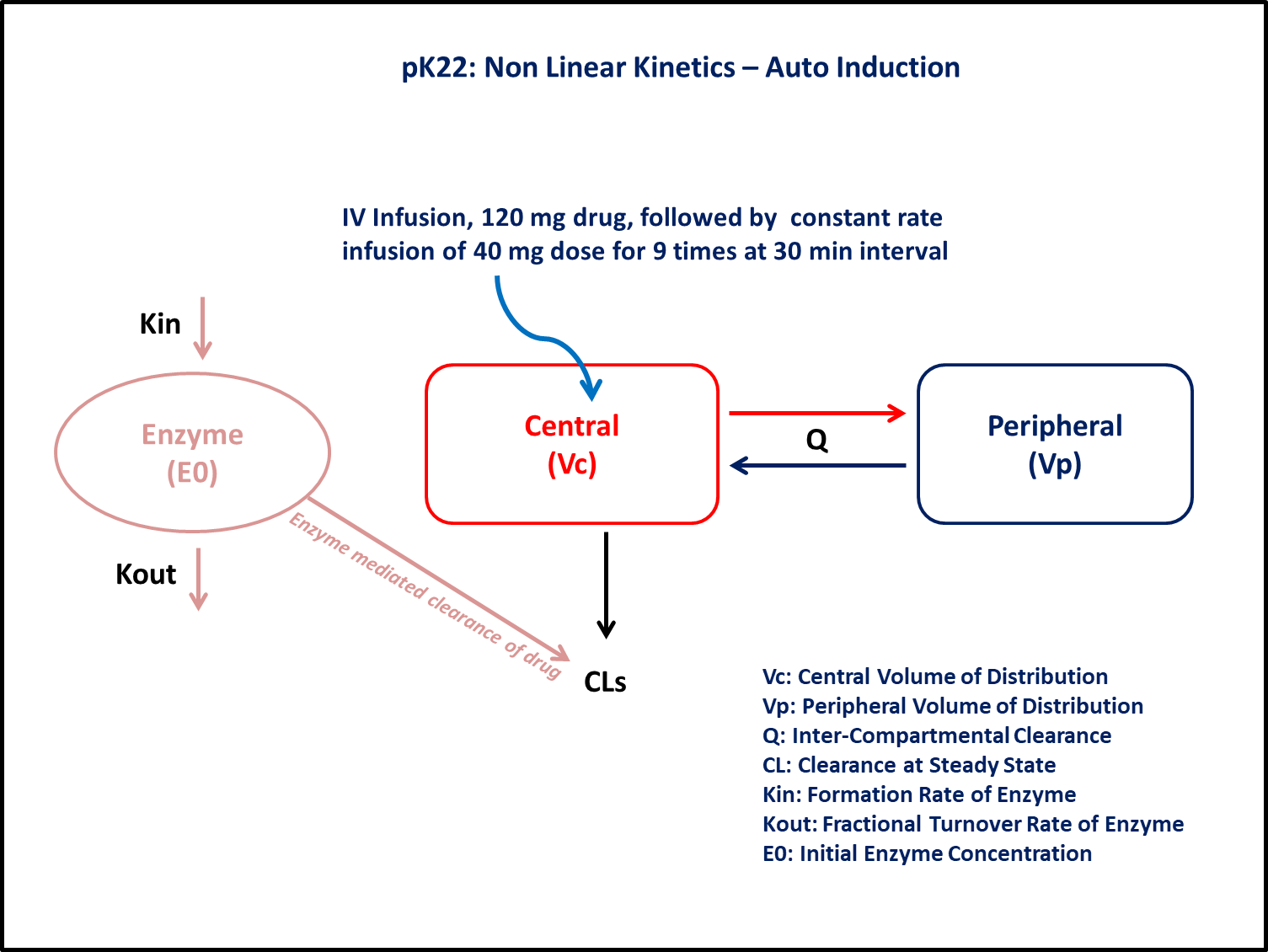using Random
using Pumas
using PumasUtilities
using AlgebraOfGraphics
using CairoMakie
using CSV
using DataFramesMeta
using Dates
PK22 - Non-linear Kinetics - Autoinduction
1 Background
- Structural model - Two compartment Model for drug and one compartment model for enzyme
- Route of administration - IV Infusion
- Dosage Regimen - 120 mg of IV infusion at a constant rate of 1 hour followed by 9 more doses of 40 mg for 30 minutes duration at the interval of 8 hours
- Number of Subjects - 1

2 Learning Outcome
This model gives an understanding of drug pharmacokinetics and enzyme autoinduction simultaneously after repeated IV infusion.
3 Objectives
In this tutorial, you will learn how to build a two compartment model for a drug and a one compartment model for an enzyme and simulate from the model.
4 Libraries
Call the necessary libraries to get started.
5 Model
In this two compartment model, we administer repeated doses of IV infusions to a single subject.
pk_22 = @model begin
@metadata begin
desc = "Autoinduction Model"
timeu = u"hr"
end
@param begin
"""
Clearance at Steady State (L/hr)
"""
tvcls ∈ RealDomain(lower = 0)
"""
Central Volume of Distribution (L)
"""
tvvc ∈ RealDomain(lower = 0)
"""
Peripheral Volume of Distribution (L)
"""
tvvp ∈ RealDomain(lower = 0)
"""
Distribution Clearance (L/hr)
"""
tvq ∈ RealDomain(lower = 0)
"""
Input Rate Constant for Enzyme (hr⁻¹)
"""
tvkin ∈ RealDomain(lower = 0)
"""
Output Rate Constant for Enzyme (hr⁻¹)
"""
tvkout ∈ RealDomain(lower = 0)
"""
Initial Enzyme Concentration
"""
tvE0 ∈ RealDomain(lower = 0)
Ω ∈ PDiagDomain(7)
"""
Proportional RUV
"""
σ²_prop ∈ RealDomain(lower = 0)
end
@random begin
η ~ MvNormal(Ω)
end
@pre begin
Cls = tvcls * exp(η[1])
Vc = tvvc * exp(η[2])
Vp = tvvp * exp(η[3])
Q = tvq * exp(η[4])
Kin = tvkin * exp(η[5])
Kout = tvkout * exp(η[6])
E0 = tvE0 * exp(η[7])
end
@init begin
Enzyme = (Kin / Kout) + E0
end
@dynamics begin
Central' =
-(Cls / Vc) * Central * Enzyme + (Q / Vp) * Peripheral - (Q / Vc) * Central
Peripheral' = (Q / Vc) * Central - (Q / Vp) * Peripheral
Enzyme' = Kin * (E0 + Central / Vc) - Kout * Enzyme
end
@derived begin
cp = @. Central / Vc
"""
Observed Concentration (mcg/L))
"""
dv ~ @. Normal(cp, sqrt(cp^2 * σ²_prop))
end
endPumasModel
Parameters: tvcls, tvvc, tvvp, tvq, tvkin, tvkout, tvE0, Ω, σ²_prop
Random effects: η
Covariates:
Dynamical system variables: Central, Peripheral, Enzyme
Dynamical system type: Nonlinear ODE
Derived: cp, dv
Observed: cp, dv6 Parameters
Parameters are provided for the simulation. Note that tv represents the typical value for parameters.
tvcls- Typical Value Clearance at Steady State (L/hr)tvvc- Typical Value Central Volume of Distribution (L)tvvp- Typical Value Peripheral Volume of Distribution (L)tvq- Typical Value Distribution Clearance (L/hr)tvkin- Input Rate Constant for Enzyme (hr⁻¹)tvkout- Output Rate Constant for Enzyme (hr⁻¹)tvE0- Initial Enzyme ConcentrationΩ- Between Subject Variabilityσ- Residual errors
param = (
tvcls = 0.04,
tvvc = 150.453,
tvvp = 54.0607,
tvq = 97.8034,
tvkin = 0.0238896,
tvkout = 0.0238896,
tvE0 = 132.864,
Ω = Diagonal([0.04, 0.04, 0.04, 0.04, 0.04, 0.04, 0.04]),
σ²_prop = 0.005,
)7 Dosage Regimen
Dosage Regimen - 120 mg of IV infusion at a constant rate of 1 hour, followed by 9 more doses of 40 mg for 30 minutes duration at an interval of 8 hours
ev1 = DosageRegimen(
[120000, 40000],
time = [0, 8],
duration = [1, 0.5],
cmt = [1, 1],
addl = [0, 8],
ii = [0, 8],
)| Row | time | cmt | amt | evid | ii | addl | rate | duration | ss | route |
|---|---|---|---|---|---|---|---|---|---|---|
| Float64 | Int64 | Float64 | Int8 | Float64 | Int64 | Float64 | Float64 | Int8 | NCA.Route | |
| 1 | 0.0 | 1 | 120000.0 | 1 | 0.0 | 0 | 120000.0 | 1.0 | 0 | NullRoute |
| 2 | 8.0 | 1 | 40000.0 | 1 | 8.0 | 8 | 80000.0 | 0.5 | 0 | NullRoute |
sub1 = Subject(id = 1, events = ev1)Subject
ID: 1
Events: 108 Simulation
Let’s simulate for plasma concentration with the specific observation time points after IV.
Random.seed!(123)The random effects are zero’ed out since we are simulating means
zfx = zero_randeffs(pk_22, sub1, param)(η = [0.0, 0.0, 0.0, 0.0, 0.0, 0.0, 0.0],)sim_sub1 = simobs(pk_22, sub1, param, zfx, obstimes = 0.00:0.01:96)SimulatedObservations
Simulated variables: cp, dv
Time: 0.0:0.01:96.09 Visualization
@chain DataFrame(sim_sub1) begin
dropmissing(:cp)
data(_) *
mapping(:time => "Time (hour)", :cp => "PK22 Concentrations (μg/mL)") *
visual(Lines, linewidth = 4)
draw(; axis = (; xticks = 0:10:100), figure = (; fontsize = 22))
end10 Population simulation
par = (
tvcls = 0.04,
tvvc = 150.453,
tvvp = 54.0607,
tvq = 97.8034,
tvkin = 0.0238896,
tvkout = 0.0238896,
tvE0 = 132.864,
Ω = Diagonal([0.0425, 0.0312, 0.0264, 0.0429, 0.0110, 0.0156, 0.0289]),
σ²_prop = 0.00140536,
)
ev1 = DosageRegimen(
[120000, 40000],
time = [0, 8],
duration = [1, 0.5],
cmt = [1, 1],
addl = [0, 8],
ii = [0, 8],
)
pop = map(i -> Subject(id = i, events = ev1), 1:50)
Random.seed!(1234)
pop_sim = simobs(
pk_22,
pop,
par,
obstimes = [
0.25,
0.5,
1,
1.25,
1.5,
3,
5,
7,
7.75,
8.5,
15.75,
16.5,
23.99,
24.5,
31.75,
32.5,
39.75,
40.5,
47.99,
48.5,
55.75,
56.5,
63.75,
64.5,
72,
72.25,
72.5,
72.75,
73,
73.5,
74.5,
76.5,
78.5,
80.5,
84.5,
90.5,
96,
],
);
df_sim = DataFrame(pop_sim)
#CSV.write("pk_22.csv", df_sim)